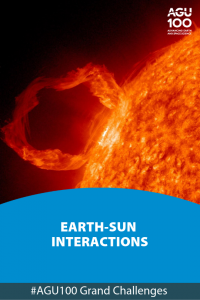 What processes are involved in the formation and evolution of the solar wind? Our Sun’s atmosphere – the solar corona – is comprised of very hot ions and electrons that continually expand outwards from the much cooler solar surface, becoming supersonic, heating to millions of degrees, and filling and impacting every object in the solar system. This is the solar wind, and is the ultimate driver of space weather that impacts our society. However, it has been notoriously difficult to determine how solar plasma is released from the sun and then heated and accelerated to supersonic speeds. (JGR: Space Physics)
What processes are involved in the formation and evolution of the solar wind? Our Sun’s atmosphere – the solar corona – is comprised of very hot ions and electrons that continually expand outwards from the much cooler solar surface, becoming supersonic, heating to millions of degrees, and filling and impacting every object in the solar system. This is the solar wind, and is the ultimate driver of space weather that impacts our society. However, it has been notoriously difficult to determine how solar plasma is released from the sun and then heated and accelerated to supersonic speeds. (JGR: Space Physics)
How can we more accurately forecast space weather that is driven by coronal mass ejections (CMEs)? CMEs are gigantic magnetized plasma clouds emanating from the Sun that cause strong to extreme disturbances in near-Earth space and related hazards for modern technology. Challenges lie ahead in developing our capability to make advance predictions of the impact severity of CMEs. Particularly challenging is understanding how the magnetized clouds deflect and deform on their way to Earth.
NOW PUBLISHED Kilpua et al. [2019] Forecasting the Structure and Orientation of Earthbound Coronal Mass Ejections (Space Weather)
How can we ensure continuous and reliable operation of global navigation satellite system signals during space weather events? Space weather creates disturbances in the Earth’s upper atmosphere. These affect the propagation of radio waves essential for space-based systems such as the Global Positioning System (GPS), potentially disrupting critical applications that rely on them such as aviation, intelligent transportation and precision agriculture. On the flip-side how can these global systems help us monitor space weather? (Space Weather)
What could machine learning and data assimilation, both of which blend into artificial intelligence, contribute to space weather research and applications? Space weather science will benefit from the data science revolution and space weather forecasting will improve with machine learning and data assimilation. The most rapid advances will occur if such tools become a formal part of space weather education and practice. (Space Weather)

